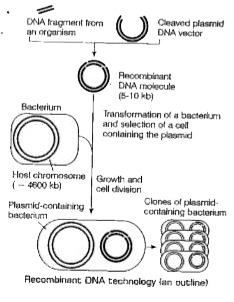Describe briefly recombinant DNA technology.Solution in Odia
Recombinant DNA technology Genetic engineering is alternately called as recombinant DNA technology or gene cloning. Paul Berg (1972) was awarded Nobel Prize in 1980 and is considered as father of genetic engineering. The first recombinant DNA (rDNA) was constructed by Stanley Cohen and Herbert Boyer in 1972.
Recombinant DNA technology involves the following steps :
(i) Isolation of the genetic material (DNA) is carried out as follows :
(a) DNA is enclosed within the membranes. To release DNA along with other macromolecules, such as RNA, proteins, polysaccharides and lipids, bacterial cells/plant or animal tissue are treated with enzymes such as lysozyme (bacteria), cellulase (plant cells), chitinase (fungus).
(b) Other molecules can be removed by appropriate treatments and purified DNA ultimately precipitates out as fine threads in the suspension after the addition of chilled ethanol.
(ii) Cutting of DNA at specific locations is done by using restriction enzymes.
The purified DNA is incubated with the specific restriction enzyme at conditions optimum for the enzyme to act.
(iii) Isolation of desired DNA fragment is carried out using agarose gel electrophoresis.
(iv) Amplification of gene of interest is done using Polymerase Chain Reaction (PCR) which is a reaction in which multiple copies of a specific DNA (gene of interest) sequence are made (amplification) in vitro.
(v) Ligation of DNA fragment into a vector requires a vector DNA and source DNA.
(a) These are cut with endonuclease to obtain sticky ends.
(b) Both are then ligated by mixing vector DNA, gene of interest and DNA ligase enzyme to form recombinant DNA.
(vi) Insertion of recombinant DNA into the host cell/organism occurs by several methods, before which the recipient cells are made competent to receive the DNA.
(a) If recombinant DNA carrying antibiotic resistance gene (e.g. ampicillin), is transferred into E.coli cells, the host cell is transformed into ampicillin resistant cell.
(b) The ampicillin resistant gene can be called a selectable marker.
(c) When transformed cells are grown on agar plates containing ampicillin, only transformants will grow and others will die.
(vii) Culturing the host cells The cell containing the foreign gene is cultured on an appropriate medium at optimal conditions. The DNA gets multiplied.
(viii) Extraction of desired gene product is carried out in the following steps
(a) A protein encoding gene expressed in a heterologous host is called recombinant protein.
(b) Cells having genes of interest can be grown on a small or on a large scale.

Topper's Solved these Questions
- BOOK - ARIHANT PRAKASHANCHAPTER - PRINCIPLES AND PROCESSES OF BIOTECHNOLOGY EXERCISE - TOPIC TEST 110videos
PRINCIPLES AND PROCESSES OF BIOTECHNOLOGY
- BOOK - ARIHANT PRAKASHANCHAPTER - PRINCIPLES AND PROCESSES OF BIOTECHNOLOGY EXERCISE - TOPIC - 2 (PRACTICE QUESTIONS) (1 MARK QUESTIONS)14videos
PRINCIPLES AND PROCESSES OF BIOTECHNOLOGY
- BOOK - ARIHANT PRAKASHANCHAPTER - PRINCIPLES AND PROCESSES OF BIOTECHNOLOGY EXERCISE - TOPIC - 1 (PRACTICE QUESTIONS) (3½ MARK QUESTIONS)13videos
PRINCIPLES AND PROCESSES OF BIOTECHNOLOGY
- BOOK - ARIHANT PRAKASHANCHAPTER - ORGANISMS AND ENVIRONMENT EXERCISE - Chapter Test (7 MARK Questions)4videos
ORGANISMS AND ENVIRONMENT
- BOOK - ARIHANT PRAKASHANCHAPTER - REPRODUCTION IN ORGANISMS EXERCISE - Chapter Test (7 MARKS Questions)4videos
REPRODUCTION IN ORGANISMS
Similar Questions
The blotting of RNA is called
03:30View SolutionWhich procedure is followed for amplification of DNA?
10:02View SolutionDifferentiate between: Exonuclease and Endonuclease.
View SolutionName different zones of a deep water body.
02:36View SolutionWrite a short note on types of layering.
03:46View SolutionDescribe the tools of recombinant DNA technology.
05:44View Solutionपुनयोर्गेज डी एन ए तकनीकी की क्रिया-विधि का संक्षिप्त वर्णन कीजिए।
04:42View SolutionWith the help of a neat and labelled diagram describe steps in recombinant DNA technology.
03:36View Solutionपुनर्योगज DNA तकनीक में इनकी उपयोगिता का वर्णन कीजिए।
02:58View Solutionक्लोनिंग वाहक क्या है ? पुनर्योगज डी.न.ए. प्रौद्योगिकी में काम आने वाले विभित्र वाहको का संक्षिप्त वर्णन कीजिए
02:38View SolutionBriefly explaing the 'cutting' and 'ligation' of DNA during recombinant DNA technology or how is recombinant DNA produced ?
11:56View SolutionDescribe the steps involved in the synthesis of insulin by recombinant DNA technology.
01:34View SolutionDefine recombinant DNA technology. Describe the various tools required for rDNA technology.
02:58View SolutionDescribe briefly recombinant DNA technology.
01:23View SolutionBriefly describe the various stages of recombination DNA technology of genetic engineering and its applications.
02:38View Solution

